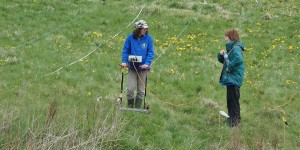The Humber Sites and Monuments Record (SMR) currently hold approximately 18,000 records, comprising all recorded historic and archaeological sites in the Hull and East Riding area. To each record, or monument, we assign a unique number – that unique reference number then relates to that monument and any relevant sources also held in the SMR. We store information in both paper and electronic format and the range of material we hold is vast – from historic maps, to aerial photographs, articles, bibliographic references and the results of archaeological fieldwork. In addition to the monument records, we also hold data on events or activities relating to archaeological fieldwork that has been carried out.
I work for the Humber SMR in an assistant role, and as such I help the SMR Officers with multiple different aspects of the work carried out in an SMR, ranging from updating the database (an on-going task as new sites and developments are coming up all the time), to helping with consulting on planning applications, such as hedgerow removals or Farm Environment Plans (FEPs). The work is immensely varied and I think that is a big attraction for people wanting to begin a career in this profession. From day to day the work is always different as the material is never the same, with new sites, new discoveries and new enhancements constantly being added to those records we already hold.
For me personally, the attraction to working in the SMR/HER (Historic Environment Record) sector is its close relationship with archaeology. Following the completion of my BSc Archaeology degree at the University of York, I was determined to find work within that area. Aside from fieldwork and academia, the choices may seem slim, but the SMR/HER offers a fascinating alternative. Working with a dataset as massive as that held by an SMR/HER means that you are constantly learning, and become intimately familiar with the archaeology and history of the area within which you work. You also get the opportunity to try and protect the heritage that exists – whether that be fighting against the removal of a hedgerow that marks a medieval open field boundary or commenting on FEPs, where you can offer management advice on how best to protect the archaeology on that land.
Public engagement is a large part of working in any SMR/HER. As a council-run department we are open, by appointment, to members of the public, who frequently come to view the records, either to research a particular site or just to learn more about their local area. In order to fully engage with the public, as well as inviting them to come to us, we also go out on visits to schools and societies, giving talks and information about what the SMR does and how to get in touch with us. The SMR therefore plays a vital role in helping the local community engage with their heritage because we offer them a direct channel to a wealth of knowledge that is already collated and freely available, providing resources that might be very difficult and time-consuming to find otherwise. It is also a mutually beneficial relationship as any new information provided by members of the public is added to our records.
In summary, working for the SMR is a constant learning process, which involves becoming intimately acquainted with the archaeology of an area and trying to protect that heritage. Public engagement is a very important consideration and we try to make people aware, and proud, of the rich and varied history of the Humber and East Riding area.









